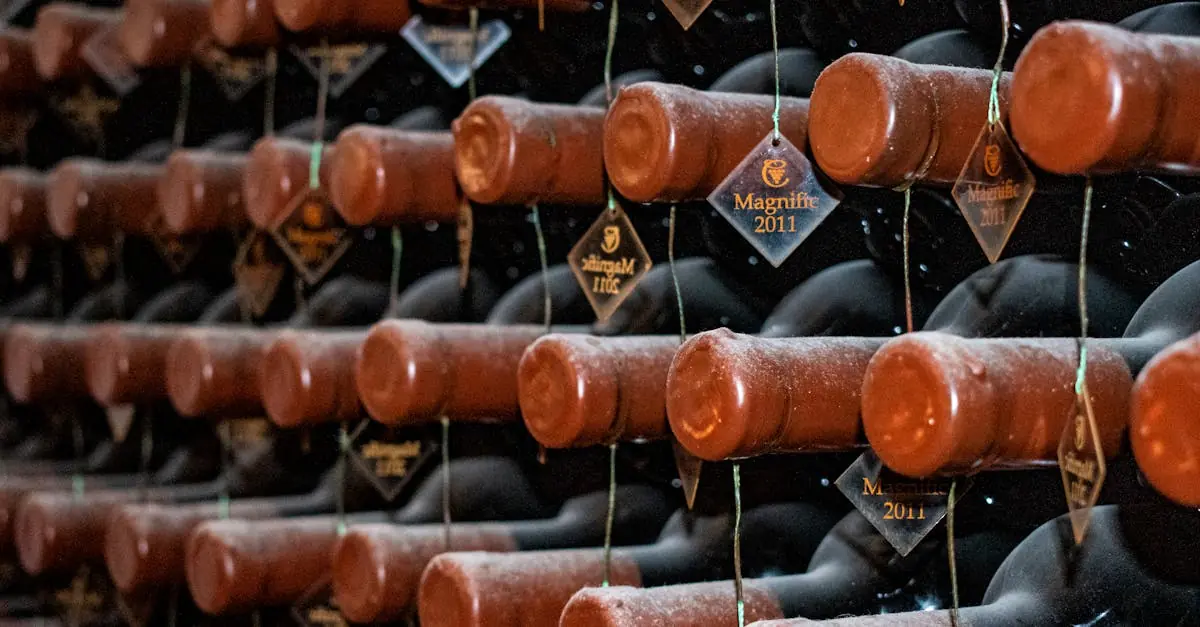Wine investing isn’t just for sommeliers and fancy dinner parties anymore. It’s become a savvy way for everyday folks to grow their wealth, one bottle at a time. Imagine sipping a fine Bordeaux while knowing its value is corked and ready to pop! With the right selection, those dusty bottles in the cellar could turn into a liquid goldmine.
Table of Contents
ToggleOverview Of Wine Investing
Wine investing involves purchasing bottles of wine to hold as assets that could appreciate in value. Investors recognize that fine wines, especially those from renowned regions, typically yield higher returns over time. Focusing on the right vintages and producers can significantly impact an investor’s profit.
Not all wines have investment potential. Limited production, high-demand regions like Bordeaux and Burgundy generally provide better investment opportunities. When selecting wines, investors often consider ratings from experts, as higher-rated wines tend to perform better in the market.
Storage conditions play a crucial role in maintaining wine quality. A controlled environment protects against temperature fluctuations and light exposure, preserving the wine’s value. Specialists recommend storing wines in wine cellars or temperature-controlled storage facilities.
The secondary market offers platforms for buying and selling wine, facilitating the investment process. Auction houses and online marketplaces allow investors to track price trends and make informed purchasing decisions. Many investors use these platforms to liquidate their holdings when conditions are favorable.
Diversification within a wine portfolio enhances risk management. By investing in various wine types and regions, investors reduce reliance on a single asset. Combining different styles, such as reds, whites, and sparkling wines, creates a balanced investment strategy.
Tracking performance is essential for successful wine investing. Keeping detailed records of purchases, storage, and sales aids in evaluating overall profitability. Investors should stay informed about market trends and changes in consumer preferences to maximize returns.
Benefits Of Wine Investing
Wine investing offers several significant advantages, appealing to a wide range of investors.
Potential Returns
Fine wines can appreciate substantially in value. Historical data indicates that top-tier wines, especially from regions like Bordeaux and Burgundy, have demonstrated annual growth rates between 8% to 15%. Provenance and ratings play critical roles in this appreciation, as wines with higher scores often fetch premium prices on the secondary market. Wine vaults report that specific vintages can triple in value after a decade. Collectors and investors both benefit when selecting bottles with limited production and strong demand. This potential for high returns makes wine an attractive asset class.
Portfolio Diversification
Incorporating wine into an investment portfolio enhances overall diversification. Different wine regions offer unique growth trajectories, mitigating risks associated with market volatility. Investors can achieve exposure to both emerging and established wine markets by selecting diverse varietals. Combining wines from regions like Italy and California with fine Bordeaux creates a balanced portfolio. The low correlation between wine values and traditional asset classes, such as stocks and bonds, further supports risk management strategies. Ultimately, this diversification can lead to steadier returns over time, appealing to both novice and seasoned investors.
Risks Associated With Wine Investing
Investment in wine comes with various risks that potential investors must consider. Recognizing these challenges can help manage expectations and investment strategies effectively.
Market Fluctuations
Market fluctuations significantly impact wine values. Prices can vary based on consumer preferences, economic conditions and global events. Specific wine regions may exhibit pronounced volatility, with prestigious areas like Bordeaux and Burgundy facing unpredictable market dynamics. Investing in well-known wines typically offers some stability, yet lesser-known wines might experience drastic price changes. Investors should remain vigilant to changing trends and market conditions to safeguard their investments and capitalize on opportunities.
Storage and Insurance Costs
Storage and insurance represent crucial ongoing expenses for wine investors. High-quality wines require optimal storage conditions to maintain their value, often necessitating climate-controlled facilities or specialized wine cellars. These expenses can add up quickly, particularly for larger collections. Additionally, insuring valuable wine bottles protects against unforeseen events like theft or damage. Investors must calculate these costs when planning their overall investment strategy, as they can significantly affect net returns. Balancing these expenses with potential appreciation is vital for successful wine investment.
How To Start Wine Investing
Starting to invest in wine involves understanding key steps and making informed decisions. This process can lead to significant financial benefits when approached correctly.
Choosing The Right Wine
Investors should focus on wines with proven track records of appreciation. Fine wines from prestigious regions like Bordeaux and Burgundy often yield better returns. Selecting bottles rated highly by experts enhances investment potential. Vintage also plays a crucial role; older wines may be more valuable. Considering limited production wines can increase scarcity and demand. Knowledge of varietals that flourish in specific climates supports smart decisions. Engaging with wine critics and industry reports aids in making informed choices.
Establishing A Budget
Creating a budget lays the foundation for a successful investment strategy. Investors typically need to consider the initial purchase price and ongoing costs for storage and insurance. Setting a specific investment limit helps mitigate risks and safeguard cash flow. Allocating funds for future acquisitions allows flexibility in expanding the portfolio. Reviewing historical performance of selected wines aids in estimating potential return on investment. Evaluating financial goals supports a balanced approach to risk. Keeping track of all expenditures related to wine investments ensures transparency and accountability.
Wine Investment Strategies
Selecting wines from renowned regions like Bordeaux and Burgundy enhances investment potential. Investors focus on limited production wines, as these tend to yield higher returns. Evaluating expert ratings remains essential; higher-rated wines consistently perform well in the market.
Storage conditions play a significant role in maintaining wine quality. Using wine cellars or temperature-controlled facilities ensures the wine’s value appreciates. Considering the secondary market is critical; auction houses and online platforms facilitate buying and selling, allowing investors to track price trends effectively.
Diversifying a wine portfolio minimizes risks significantly. Combining different wine types and regions creates a balanced approach, enhancing overall investment performance. Regularly tracking performance through detailed records aids in managing investments. Keeping comprehensive documentation of purchases, storage, and sales helps investors make informed decisions.
Establishing a budget is vital for wine investment success. Factors like initial purchase prices and ongoing storage costs must be considered. Setting investment limits mitigates risks, aligning with financial goals. Reviewing historical performance provides insight into potential returns, emphasizing informed decision-making.
Engaging with industry trends keeps investors knowledgeable. Staying aware of changing consumer preferences and market conditions can optimize strategies. Additionally, historical growth data shows top-tier wines experience annual appreciation rates between 8% and 15%. Investors should prioritize wines with proven appreciation records, ensuring their portfolios build value over time.
Wine investing presents a unique opportunity for individuals seeking to diversify their portfolios and capitalize on the appreciation potential of fine wines. With careful selection and attention to market trends, investors can unlock substantial returns while enjoying the process.
Understanding the importance of provenance and expert ratings can significantly enhance investment decisions. Additionally, maintaining optimal storage conditions is essential for preserving wine quality and value.
By approaching wine investing with informed strategies and a focus on diversification, individuals can navigate this fascinating market with confidence. As the landscape continues to evolve, staying engaged with industry developments will be key to maximizing returns and minimizing risks.



